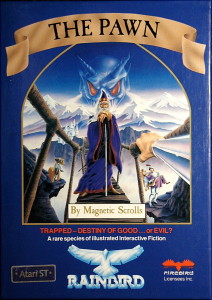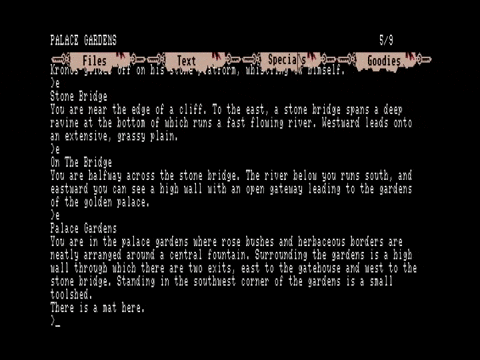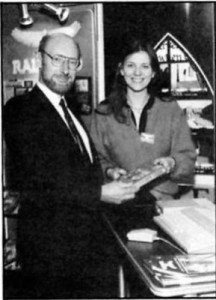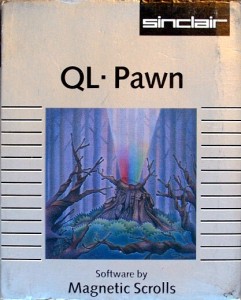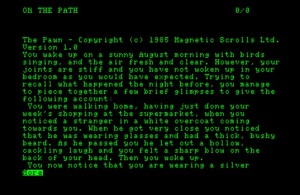Two adventure games overshadowed all of the others in North America during 1986. The success of one of these could have been predicted long before it reached store shelves. Leather Goddesses of Phobos combined the Infocom brand, slightly battered by recent events but still widely regarded as the premiere label in adventure gaming, with Steve Meretzky, the company’s most popular and populist author, working in his wheelhouse of science-fiction comedy. And on top of that it added the ultimate temptation: sex. How could it not become a hit?
The year’s other big game, however, was not such a predictable proposition, coming unexpectedly out of left field in the form of a brand new company from the United Kingdom of all places. As I’ve already written, Magnetic Scrolls’s The Pawn wasn’t a terribly good game in a whole lot of very important ways. Yet that was hard to notice at the time in the face of its more immediately obvious strengths. Not only did it offer as much text as the typical Infocom effort combined with a parser that was at least superficially competitive with Infocom’s own, but it absolutely blew Infocom away when it came to presentation, sporting several dozen illustrations of unprecedented quality. Whatever else you could say about it, The Pawn was the best looking text adventure yet released. When one of those magnificent images scrolled down onto the screen the average player’s critical faculties scrolled off to oblivion to make space for it. The Pawn‘s success in both North America and Europe, which could largely be attributed to those pretty if irrelevant pictures — one could turn them off entirely without losing anything other than a bit of atmosphere — was made doubly strange by the fact that a year before its year of triumph it had already made one debut as a humble text-only adventure, only to die quickly of a fatal case of wrong-horse-backing in the form of the Sinclair QL. Yet here it was again. Sometimes you just can’t keep a good — or, in this case, superficially good — game down.
A number of fortuitous circumstances led to The Pawn‘s unlikely revival as a next-generation graphical showcase. The first of them was the sheer stubbornness of Magnetic Scrolls’s managing director Anita Sinclair, comparable to that of her beloved bull terrier Murdoch who made a habit of terrorizing visitors to the company’s offices. When it became clear that the QL was a flop and that the text-only adventure game she, Ken Gordon, and Hugh Steers had been working on for over a year couldn’t hope to sell more than a dribble, she was determined to keep going, to try again with other games on other platforms. She therefore arranged a meeting with Tony Rainbird at British Telecom, hoping to sell him on a couple of action-game prototypes she and the boys had knocked together during down times. He turned out to be nonplussed by those games, but, much to her surprise, keenly interested in her misbegotten, foredoomed text adventure.
And so Tony Rainbird’s passion for adventure games became the second of those fortuitous circumstances. Yes, this slick, gregarious would-be mogul genuinely loved adventure games, genuinely believed they could become the basis for an interactive literature of the future. Keeping as he always did one eye cocked toward North America, he was very aware of Infocom’s progress toward turning text adventures into interactive fiction, and felt keenly his own country’s failings in this regard. British programmers, writers, and designers were, he was convinced, every bit as talented as their American peers, but they had been ill-served to this point by the more primitive, usually cassette-driven hardware they had been forced to target as well as by British gamers’ predilection for cheap, simple games in lieu of the bigger, more ambitious releases typical across the pond. He thus saw adventure games as a major focus — perhaps the major focus — of his new luxury label Rainbird, designed as it was to compete with North America on its own terms with big, ambitious titles of its own. He had already started to pursue the most respected and consistent name in British adventure gaming, believing that he could take their games from Level 9 to whatever level Infocom was on by giving them better packaging, better (i.e., international) distribution, and better hardware. And then along came Anita Sinclair.
In retrospect at least Tony’s interest in The Pawn seems natural, for it had been consciously designed to challenge Infocom, just as Rainbird had been to challenge American software in general. He was doubly interested when he learned that Magnetic Scrolls had granted only the rights to a QL version of The Pawn to Sinclair Research. There followed an intriguing proposal. Could Magnetic Scrolls port the game to other platforms and add some graphics? If they could do those two things for him, he could sell The Pawn all over the world as part of the collection of high-end, high-concept software he was now putting together.
Graphics had long since become a requirement for any kind of success in the British adventure market, as Tony was well aware; he may have been a text-adventure idealist, but he wasn’t stupid. Yet they proved to be a hard sell to Anita. While certainly excited by the idea of giving The Pawn a new lease on life, she was ambivalent about adding pictures. Indeed, she would never entirely shed her ambivalence on the subject. Heavily influenced by Infocom on this point as in so much else, she would declare even after Magnetic Scrolls had become known largely on the basis of their graphics that “if you have graphics it takes away from your own imagination and dilutes the imagery,” and admit that she often preferred to play her company’s games with the graphics off.
That said, many of her initial objections were practical rather than ideological. The pictures that had long since become standard equipment in all but the most modest, home-grown British adventures were almost universally what was known as line-drawn or vector graphics, a technique pioneered by Ken Williams in the United States way back in the days of Mystery House and The Wizard and the Princess. Under this technique graphics were stored not as pictures but as a series of instructions for drawing a picture: draw a line from this point to this point in this color, fill a rectangle having these boundaries in this other color, etc. The computer then recreated the image at run-time by stepping through this sequence of instructions. In the hands of masters of compression like the Austin brothers at Level 9, vector graphics could be packed by the hundred onto a single disk or cassette. Unfortunately, though, the nature of their creation limited them to straight lines, regular curves, and geometric solids filled in using a handful of primary colors layered on in big, garish swathes; anything like artistic subtlety went right out the window. That hadn’t always mattered all that much in the past, when the visual capabilities of the computers on offer, what with their low resolutions and limited color palettes, couldn’t manage much subtlety anyway. But clearly the traditional method made a poor fit for the new Atari ST, the machine that Tony Rainbird wanted Magnetic Scrolls to target first.
The alternative approach, used occasionally by companies in the United States like Telarium and enabled by the luxury of the disk drives that were common there, were bitmap graphics, where the color of each individual pixel that made up the picture was stored, one after another. While compression techniques could be used to shrink the size of the resulting file somewhat, pictures stored in this way nevertheless used vastly more space. Telarium’s games, for instance, which were generally much smaller than those of Level 9 that shipped on a single disk or cassette, routinely sprawled across four or even five disk sides thanks to their pictures. Still, bitmap graphics was the approach that Tony now advocated to Anita. The ST’s disks could store a lot more data than disks on the 8-bit machines or, God forbid, an 8-bit cassette. And it wasn’t really necessary to illustrate every single location in the game like Telarium did, just a reasonable subset of the more picturesque and interesting.
Tony even had someone in mind to make the pictures, a young artist and art-history scholar named Geoff Quilley who had just the sort of classy, classical sensibility that Tony and Anita alike wanted for the games of Magnetic Scrolls. Based in Oxford, Quilley had painted portraits as well as a mural for Wadham College, and had already done the graphics for a high-brow 8-bit adventure game based on Shakespeare’s Macbeth. Nowadays he was doing amazing things with NEOchrome, the simple little paint program that shipped with every Atari ST. When Anita still proved reluctant, Tony made her an offer that was difficult to refuse: give Quilley a week or so to illustrate one or two locations from the game, and see if she wasn’t convinced that they could add to The Pawn‘s commercial appeal without being an aesthetic embarrassment. She did, and she was. Quilley would remain with Magnetic Scrolls for years as their art director, drawing himself many of the pictures that would become the chief selling point of their games and supervising an eventual team of artists who drew the rest. Through it all he would remain inflexibly loyal to Neochrome and the Atari ST, even as Anita tried from time to time to tempt him with more advanced Amiga paint programs like Deluxe Paint. He liked to say that the results he got with his primitive tools spoke for themselves, and it was hard to argue with him after you’d had a look.
With their artist now on the job making the pictures, Magnetic Scrolls’s next challenge was to port The Pawn to the Atari ST and to find a way to add said pictures to an adventure game which they had never anticipated would need to contain them. For all that they had modeled so much of The Pawn after Infocom’s efforts, they had neglected to follow Infocom’s lead in one very important way. Instead of running in a virtual machine like Infocom’s Z-Machine, their adventure system compiled down to native 68000 machine language on the QL. Luckily, however, the Atari ST used the same 68000 processor as the QL, so the porting task wasn’t too daunting. The pictures proved to be the biggest challenge: they were done in low resolution so as to allow a palette of 16 colors, but the text really needed to be done in the ST’s 4-color medium-resolution mode so as to allow 80 columns. Magnetic Scrolls thus came up with a way to mix the two modes on the same screen, an impressive technical accomplishment in itself. The pictures could be unveiled by using the mouse to slide them down over the text like a window blind. Not only was it an ingenious way to maximize limited screen real estate, but in its day it was an absolutely stunning special effect, one that doubtless sold a fair few copies of The Pawn all by itself. The new engine also took advantage of the ST’s comparatively capacious memory to implement a number of other commonsense conveniences of the sort that Infocom really should have been adding to their own games for the bigger machines by this point, like the abilities to assign common commands to function keys and to recall the last command for editing.
But of course the Atari ST version was only the beginning. Many other platforms also awaited. The Macintosh and the Amiga, being yet more machines based on the 68000, were fairly easy marks. The Amiga version did get one notable addition: a theme song by John Molloy, one half of the pioneering synth-pop duo Mainframe, whose own DS:3 sampler, built around an Apple II, was enjoying some popularity; three, for instance, had been employed as part of the Live Aid stage setup. The songs of Mainframe themselves were getting a fair amount of play in British clubland, making the acquisition of Molloy’s services something of a coup for Magnetic Scrolls. The Pawn‘s theme, featuring a surprisingly lifelike acoustic guitar amongst other sounds, became one of the first to demonstrate the potential of sampled, as opposed to synthesized, instruments for game music.
The other ports were, alas, more fraught propositions, entailing as they must artful degradation rather than enhancement. In what can only be described as a masterful technical achievement, Magnetic Scrolls came up with a way to emulate enough of the 68000 instruction set on other processors to run the game. Even more incredibly, they somehow made it run fast enough on the little 8-bit Z80 and 6502 to be acceptable. They hired another artist, Tristram Humphries, to duplicate as best he could each of Quilley’s pictures on a Commodore 64. These were then used in ports not only to the 64 but also to a number of other 8-bit platforms. In cases where it was just hopeless to produce graphics with anything like fidelity to Quilley’s originals, as on the Apple II and the Sinclair Spectrum, the graphics were left out entirely.
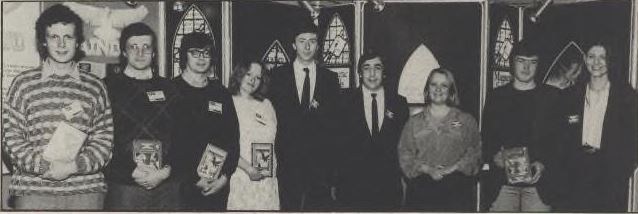
The leading lights of British adventure gaming assemble under the Rainbird banner. From left: Mike, Pete, Nick, and Margaret Austin of Level 9; Mike Clarke, Tony Rainbird, and Paula Byrne of Rainbird; Ken Gordon and Anita Sinclair of Magnetic Scrolls.
Rainbird and Magnetic Scrolls went public with their new partnership at the Winter Consumer Electronics Show in Las Vegas in January of 1986; the choice of venues was a telling indicator of their hopes of challenging Infocom on their home turf. That April the finished Atari ST version of The Pawn was debuted in Britain in a big joint event featuring not only the principal players from Rainbird and Magnetic Scrolls but also the Austin family who ran Level 9, and whom Tony Rainbird had now also successfully courted for his new label. Tony and Anita even managed to convince Anita’s erstwhile mentor Clive Sinclair to drop in and lend some of his aura to the proceedings. The Pawn‘s big box that was unveiled that day included a glossy poster and, Tony being quite the fan of in-box novellas, A Tale of Kerovnia, a clever if superfluous stage-setting story written by Anita’s sister Georgina. The box also contained ciphered hints to be typed into the game itself for decryption. The Pawn may have been riddled with nonsensical puzzles, but at least players wouldn’t have to buy a hint book to get past them.
While the price of the game prompted shock — fully £20, £2 more than even the disk version of Elite — those gorgeous pictures sent even bigger waves through the British gaming community. Their importance to The Pawn‘s success can hardly be overstated. Whatever their value or ultimate lack thereof for the hardcore player, they gave the magazines visual pop to accompany coverage of the game. The Pawn made for a damn good cover; an Infocom game, not so much. In Computer and Video Games magazine, Keith Campbell, the most widely read adventure-game commentator in Britain, gave The Pawn its first big review. It was gushing: 10 for “Vocabulary,” 10 for “Atmosphere,” 10 for “Personal” (how’s that for an arbitrary scoring system?). He described the game as a well-nigh revolutionary product, “in most respects superior” to Infocom even if the graphics were discounted, destined to cause “the standard of software demanded by adventure players to skyrocket.” There was just something about The Pawn — and Anita Sinclair; we’ll get to that momentarily — that could turn even a hardened reviewer like Campbell to jelly. His review was such a coup that Rainbird shipped copies of that issue to North America along with the first copies of The Pawn to get a buzz going.
They needn’t have worried about it. The Pawn hit American shores like a hurricane. Reviewers there, as in Britain, just couldn’t seem to find enough superlatives with which to stamp it. It even did quite well in continental Europe, particularly the computing (and Atari ST) hotbed of West Germany. For that market Rainbird translated the novella, but left the text in the game alone; making the parser parse German was a task that no one at Magnetic Scrolls had the linguistic chops to manage. Undaunted, tens of thousands of Germans struggled valiantly with the oft-gnarly English text, laced as it was with slang and idiomatic usage. It was presumably all worth it for the pictures.
But graphics were just one of The Pawn‘s not-so-secret weapons, the other being the potent comeliness of Ms. Anita Sinclair. The British press, who had the most regular access to Anita and her charms, were the most smitten. One magazine admitted frankly that it would “grab any excuse to print a picture of Anita.” It’s hard to believe that national magazines with editorial staffs and all the rest actually published some of this stuff. Take this (please!) from Amtix: “The lovely Anita Sinclair came up to Ludlow especially to show me The Pawn. Well, I was really impressed… and the game was good too!” Keith Campbell, writer of that aforementioned glowing Pawn review, called his journalistic integrity into question and also shared much more than anyone really needed to know about his private fantasies when he put “Anita Sinclair in a brass bikini” on his year-end list of things he’d like to see in 1987. An even weirder Boris Vallejo-inspired fantasy life seemed to be lived by the writer who gave her the out-of-nowhere appellation of “ice maiden.”
That gem appeared in Sinclair User. And, indeed, it was that magazine that developed the most sustained obsession with all things Anita. A contest announcement there said they’d really wanted to gift the winner with “a fantastically beautiful and intelligent companion,” but, alas, “Anita Sinclair is already spoken for,” so readers would have to settle for a light gun instead. (Presumably she’d finally been forced to use the “I have a boyfriend” line on one of them.) In a year-end roundup Sinclair User‘s readers elected her “Most Attractive Programmer,” a category that mysteriously hadn’t existed the year before. (The many write-in voters who opted for “any female programmer” gave a perhaps even more disturbing glimpse of the state of the average reader’s love life.) This is not to say that the verdict was unanimous, mind you. For some time afterward debate raged over whether Anita really was All That. One letter writer weighed in on this pressing issue with particular force. “Anita Sinclair is about as attractive as a pig’s bottom!” he declared with a noble lack of equivocation. (One wonders what his girlfriend looked like.)

This photograph of Clive Sinclair and Anita Sinclair was used for a captioning contest by Sinclair User. “Juvenile sexist comments might be sniggered over in the office but won’t be printed and won’t win and that’s that,” they announced. Good to know they were fighting the good fight.
But my absolute favorite from this delightful little sub-genre is The Games Machine‘s review of Fish!, a later Magnetic Scrolls game. This — I kid you not — is the opening paragraph:
Anita Sinclair looks fab! I’ve always liked the lady but now that she has put on a little weight since giving up smoking she looks gorgeous. What a pity that on the day she took me to lunch (oh, do get on with it! — Ed.) she could barely walk due to some very painful blisters on her feet. She was also suffering from having a jolly good time at the Telecomsoft dinner the night before where the wine was free! Apart from discussing the PC show, other magazines, adventures in general, and her Audi Quatro, we did eventually get round to Magnetic Scrolls’s new game, Fish!.
As the extract above attests, Anita treated her little coterie of admirers with the bemused tolerance of the popular girl at school who deigns to let the lower social orders sit at her lunch table from time to time. She tactfully buffeted away questions like “Who would you most like to kiss under the mistletoe?” whilst gamely trying to focus her interviewers’ attentions back on the games in question. When some of her more sensitive interlocutors asked her feelings on all of the unwonted attention, she remained coy: “There is obviously interest in me because I’m female, but I don’t notice it very much. I think it could be an advantage.” Nor is there any sign that the other folks who worked at Magnetic Scrolls ever felt slighted by the attention lavished on Anita. To hear the magazines tell it, every Magnetic Scrolls game was practically a solo effort by Anita, even as in reality she drew none of the pictures, wrote very little of the text, and contributed to the designs only as a member of a larger team betwixt and between coding much of Magnetic Scrolls’s technical plumbing and of course running the company. The lack of outrage on the part of all parties at Magnetic Scrolls isn’t hard to explain: in a hugely competitive text-adventure market in which everyone was scrambling for a slice of a steadily shrinking pie, the attention Anita generated was precious, the best PR move Magnetic Scrolls didn’t have to actually make.
So, yes, there was a lot of smoke and mirrors behind the huge success of The Pawn, born of those pretty pictures and that pretty Anita and a media, heavily influenced by both, that was all too eager to see it as an Infocom-killer. In its way The Pawn is every bit as much a period piece as Starglider. Pointless parser permutations like the famous “USE THE TROWEL TO PLANT THE POT PLANT IN THE PLANT POT” aside, Magnetic Scrolls still had a long way to go to rise to Infocom’s level. A comparison of Leather Goddesses of Phobos with The Pawn doesn’t do the latter any favors. One design is air-tight, the other shambolic in all the worst ways. Magnetic Scrolls would get much, much better in their future games, but remains to this day slightly overrated in my opinion, benefiting just a bit too much from the awe so many of us felt back in the day when we saw those pictures for the first time. Much as their Infocom fixation might lead one to suspect otherwise, Magnetic Scrolls did innovate in their own right in some areas having nothing to do with graphics. Indeed, their later games sometimes verge on brilliance. But they always seem to disappoint almost as much as they delight, dogged by a frustrating inconsistency born, one suspects, largely from the lack of a testing regime to match Infocom’s and a willingness when under pressure to ship to let some things go — parser non sequiturs, weird text glitches, underimplemented or underdescribed objects, puzzles that just don’t quite make sense — that Infocom wouldn’t.
Which is not to say that Magnetic Scrolls isn’t worthy of attention. Far from it. Their games are the most technically advanced and literate text adventures that the British games industry would ever manage. We’ll thus be looking at all of the Magnetic Scrolls games that followed The Pawn, beginning with the next two in my next article. Whatever else happens, I certainly won’t have to pan any of them quite as badly as I did The Pawn.
Before I leave you today, though, it’s worth thinking one more time about 1986, the year of the twin commercial triumphs of Leather Goddesses of Phobos and The Pawn. While no one could possibly have been aware of it at the time, it would turn out to mark the end of an era. Text adventures as a commercial proposition still had a few years to go; rest assured that some of the most interesting specimens of the species are still waiting to get their due in future articles. Yet the number of companies working in the field was dwindling, and the genre would never again manage even one, much less two games in any given year with the commercial prominence of Leather Goddesses and The Pawn. Far from taking the text adventure to new heights, as Magnetic Scrolls and Rainbird were confidently predicting, the new 16-bit machines and the games that ran on them would for better or for worse transcend it entirely. Like the contemporary players who remained loyal to the genre, we’ll just have to enjoy the gems of this twilight era while they last.
(Sources for this and the next article: Zzap! of July 1987 and December 1988; Crash of August 1988; ZX Computing of August 1986; Computer and Video Games of December 1985, April 1986, July 1986, May 1987, October 1987, and February 1988; Your Computer of January 1988; Amtix of February 1987 and March 1987; Atari User of June 1986; Questbusters of October 1987; Popular Computing Weekly of January 23 1986; Commodore User of December 1986; Sinclair User of January 1987, February 1987, April 1987, October 1987, February 1988, and August 1989; The Games Machine of December 1987 and November 1988. There are two excellent websites dedicated to Magnetic Scrolls: The Magnetic Scrolls Memorial and The Magnetic Scrolls Chronicles. Francesco Cordella also conducted an interview with Rob Steggles, writer for The Pawn and two of Magnetic Scrolls’s eventual six other text adventures, which is available on his website.
The Magnetic Scrolls Memorial hosts an interpreter that will run the Magnetic Scrolls games on many platforms along with all of the games in a form that is ready to run under it. This is certainly the most painless way to play them today. That said, I think these games are actually best experienced as originally presented via an Atari ST or Amiga emulator. In that spirit, I’ve prepared a download of The Pawn with disk images for both platforms and all the other goodies that came in the box for those of you who are hardcore like me.)
